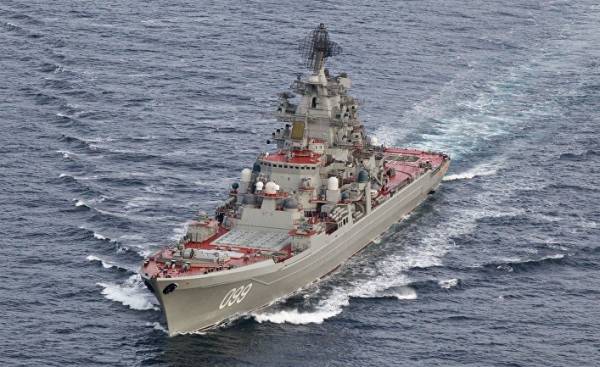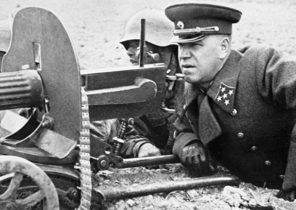
Over the past year, the Russian Navy has taken several where it attracted a lot of attention operations, among which we can point to the direction of the aircraft carrier “Admiral Kuznetsov” to the shores of Syria, as well as launches of cruise missiles from warships in the Caspian sea. The activity of Russian submarines has also increased, although it has not yet reached the level that existed during the cold war.
The best advice for Moscow would be the following verse from the gospel of Matthew, in which we are talking about the adventures at sea: “Watch and pray, lest you enter into temptation: the spirit indeed is willing, but the flesh is weak” (26:41). The Russian Navy is in disarray, and perhaps it will become even more chaotic.
Existing ships
Russia inherited a huge modern fleet of surface ships and submarines. Many of them quickly came into disrepair, because Russia was not able to maintain a fleet of this size. Remaining core ships of the Russian Navy are very old, and some are in repair, while their condition raises questions. Of the 24 main ships of the Russian Navy three (class frigates “Admiral Grigorovich”) was founded after the end of the cold war. Most of the remaining ships of the former Soviet Navy are approaching the end of their use, although Russian is taking some action to refurbish and upgrade part of its fleet.
How long Russians will be able to support the aircraft carrier “Admiral Kuznetsov” in a sense, afloat without large-scale re-equipment is a serious matter, however, despite ambitious promises, replace it on the stocks yet. Nuclear missile cruiser “Peter the Great” is the fleet in the last ten years, and, in addition, there are more and more reports that “Admiral Nakhimov” will be back in a couple of years, but both ships for more than 30 years.
Future projects
If Russia built all those ships, which she promised to build over the last decade, then the Russian Navy, in fact, would be a fleet of the world level. Russia’s policy in the area of national security differs in more statements about large projects than the fulfillment of promises made. A valid list of construction of the Russian surface ships, according to international standards, produces a rather gloomy impression.
The biggest success of the Russian shipbuilding are the frigates “Admiral Grigorovich” (a displacement of 4 thousand tons) and “Admiral Gorshkov” (5.4 thousand tonnes). The first of them was built for about seven years, and the last about nine years. Two frigates of the class “G.” accepted into the fleet, and four more are in the process of construction. The first frigate of the class “pots” will be adopted into the fleet later this year, and three ships under construction.
 © RIA Novosti, Nina zotina | go to Photobacterium ship “Admiral Grigorovich”
© RIA Novosti, Nina zotina | go to Photobacterium ship “Admiral Grigorovich”
In contrast, the British took about six years to build destroyers “Type 45”, the Americans about four years to build a destroyer class Arleigh Burke, the Japanese spent four years on the construction of the cruiser Atago, and the Chinese took about four years for the construction of the destroyer “Type 052D”. All of these ships about two times more of those frigates that Russia with great difficulty trying to finish.
12 ships of the class “Leader” (a displacement of 17 tons) without difficulty could replace existing cruisers, but there is little indication that the Kremlin is going to build those ships, not to mention the fact, to finish their construction within a reasonable time. The recent economic crisis in Russia further complicated the decision-making on the construction of warships. Moreover, the capture of the Crimea was deprived of the opportunity to make purchases abroad (primarily helicopter class “Mistral”), although at some point, Russia may consider the possibility of buying ships from China.
Submarines
The strength of the Russian position largely depends on an assessment of the centrality of nuclear submarines in a naval capacity. Nuclear submarines with ballistic missiles, and shock, in fact, are the only area in which Russian shipbuilding industry after the end of the cold war has reached good results.
Although the size of the submarine flotilla was reduced (13 of strategic nuclear submarines, 7 nuclear submarines equipped with cruise missiles, 17 nuclear-powered attack submarines and 20 diesel submarines — their number depends on which of them are in fighting condition at the moment), the Russian Navy is hard at work for the replenishment submarines and its update. Eight submarines of class “Borey” (three of them are already part of the Russian Navy, and another five are under construction) should serve as an effective element of deterrence in the foreseeable future, I am shock submarines of class “Ash” represent a contemporary addition to the existing submarine ships of the class “Barracuda”, “Granite” and “Shark”.
Comparison
XX century proved to be interesting for the Russian fleet. In 1905 Russia was, of course, was not the naval power of the first level, but had a considerable modern fleet in the Baltic sea in the Pacific ocean and in the Black sea. The destruction of the first two fleets by the Japanese was the cause of the crisis, but 13 years after the battle of Tsushima, Russia had adopted seven dreadnoughts, despite the destruction caused by the first world war. Due to this, Russia gained a solid place in the same company, where France and Italy, however, it lagged far behind Britain, Germany, Japan and the United States.
The Bolshevik revolution — as well as the collapse of the Soviet Union — simultaneously made to strengthen the existing forces and to abandon plans for new construction. As the Russian Federation, the Soviet Union in the first 20 years of its existence, had no clear plans for their Navy, but then (before world war II) started to implement an ambitious program in this area. The war disrupted existing plans, but, nevertheless, forced to make a clear conclusion: the power of Russia and its security is connected with its ground forces, not the Navy. However, the Soviet Navy is constantly increasing its power in the cold war years, and at some point, clearly surpassed in this respect, France and Britain, becoming the second on the force and capabilities of the naval fleet in the world.
But then everything once again fell apart. The Russian Navy has not been able to maintain those ships, which he had inherited, and he’s even less were able to afford the pace of construction of new ships, which would allow to maintain the normal state of the shipbuilding industry. The result is a death spiral — the cost of maintenance of old ships increased, while the quality of maintenance and construction decreased. The financial crises of the last few years, due to a combination of sanctions and collapse of oil prices helped to suppress signs of life in all areas, with the exception of submarines.
International comparison is not in favor of Russia. China will have at least three aircraft carrier by the time when Russia will adopt its second aircraft carrier, India will have at least two aircraft carriers, like the UK. From the point of view of ordinary ships warships, the situation looks bleak. As has been said, France, Britain, Japan and China over the past ten years has commissioned more meaningful, more large surface warships, and they are clearly superior in its class, Russia inherited the legacy of the ships with respect to their technological level. Especially striking in comparison with China, while Russia from 2000 year, has expanded its fleet with five important surface warships, China has adopted about 40. This comparison will be even more in favor of Russia in the next few years.
The results
As said Gorenburg Dmitry (Dmitry Gorenburg), Moscow’s ambitions in the area of the Navy are painfully unrealistic. Until then while Russia will not restore its shipbuilding industry, it will not be able to compete with China, Japan or South Korea. While Russia will not rebuild its economy, it cannot restore its shipbuilding industry. Despite significant investments in defense, Russia, apparently, has the ability to compete only in a narrow segment — nuclear attack submarines, nuclear submarines with ballistic missiles on Board and medium-size frigates and corvettes. Among the achievements of Russia can be attributed to the good work of installing a new missile technology to existing platforms.
Finally, mention should be made of the fact that the modern Russian Federation is facing the same difficulties in the Maritime field, and its predecessors, the Soviet Union and the Russian Empire. The Russian Navy is divided into four parts (the black sea fleet, Baltic fleet, Northern fleet and Pacific fleet), and none of them is able to easily support the other. The transfer of “Admiral Kuznetsov” in the Mediterranean sea, and its return without serious damage was seen as a great achievement. In contrast, China has three regional fleet, which is not far from each other.
In short, the Russian fleet is in bad shape, and Russia is unable to restore it. In the foreseeable future Russia will engage in those projects in the field of construction of warships, which are absolutely necessary and that she’s good at it. It is mainly refers to the fleet of nuclear submarines that can create the potential for deterrence, as well as to a small surface fleet performing normal operations for offshore support. Everything else, apparently, is beyond the existing capabilities.







